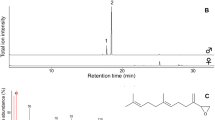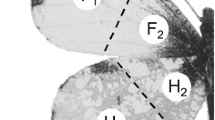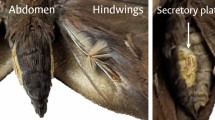Abstract
Adults of some butterfly species have odors, several components of which are known to have pheromonal or defensive functions. Little is known about the odors of hesperiid butterflies, however. Erynnis montanus (Hesperiidae), especially male adults, emit a pungent odor that is detectable by the human nose. Chemical analysis has revealed that crude extracts of wild individuals contained 10 volatile substances, of which docosane and heneicosane were the main components. Because males contain a significantly larger amount of p-cresol than females, this aromatic compound is characterized as a strong male odor. At the end of the adult occurrence period, p-cresol decreased substantially in each male. Benzothiazole, identified for the first time in lepidopteran adults, was present in both sexes in almost equal amounts. Among the 10 volatile substances detected in males, biased distribution in the wings rather than the body was observed for benzothiazole, heptanal, and p-cresol. Male adults have androconial organs in the costal part of the forewing on which benzothiazole and p-cresol tended to concentrate. However, these compounds were detected not only in other parts of the forewing but also in the hindwing and body, suggesting the presence of undiscovered scent-producing organs.


Similar content being viewed by others
References
Andersson J, Borg-Karlson A-K, Vongvanich N, Wiklund C (2007) Male sex pheromone release and female mate choice in a butterfly. J Exp Biol 210:964–970. doi:10.1242/jeb.02726
Babilis NA, Mazomenos BE (1992) Pheromone production in Sesamia nonagrioides: diel periodicity and effect of age and mating. J Insect Physiol 38:561–564. doi:10.1016/0022-1910(92)90106-N
Boppré B (1989) Chemically mediated interactions between butterflies. In: Vane-Wright RI, Ackery PR (eds) The biology of butterflies. Princeton University Press, Princeton, pp 259–275
Boppré B (1993) The American monarch: courtship and chemical communication of a peculiar danaine butterfly. In: Malcolm SB, Zalucki MP (eds) Biology and conservation of the monarch butterfly. Natural History Museum of Los Angeles County, Los Angeles, pp 29–41
Dapporto L (2007) Cuticular lipid diversification in Lasiommata megera and Lasiommata paramegaera: the influence of species, sex, and population (Lepidoptera: Nymphalidae). Biol J Linn Soc 91:703–710. doi:10.1111/j.1095-8312.2007.00833.x
Drilling K, Dettner K (2010) First insights into the chemical defensive system of the erotylid beetle, Tritoma bipustulata. Chemoecology 20:243–253. doi:10.1007/s00049-010-0054-2
Eisner T, Eisner M (1990) p-Methoxyphenol: chemical basis of stench of a female butterfly. Naturwissenschaften 77:33. doi:10.1007/BF01131794
Eisner T, Alsop D, Hicks K, Meinwald J (1978) Defensive secretions of millipedes. In: Bettini S (ed) Arthropod venoms. Handbook of experimental pharmacology, vol 48. Springer, Berlin, pp 41–72
El-Sayed AM (2009) The Pherobase. http://www.pherobase.net/
Fukuda H, Hama E, Kuzuya T, Takahashi A, Takahashi M, Tanaka B, Tanaka H, Wakabayashi M, Watanabe Y (1984) Erynnis montanus Bremer. In: The life histories of butterflies in Japan, vol IV. Hoikusha, Osaka, pp 184–193 (in Japanese)
Hay-Roe MM, Lamas G, Nation JL (2007) Pre- and postzygotic isolation and Haldane rule effects in reciprocal crosses of Danaus erippus and Danaus plexippus (Lepidoptera: Danainae), supported by differentiation of cuticular hydrocarbons, establish their status as separate species. Biol J Linn Soc 91:445–453. doi:10.1111/j.1095-8312.2007.00809.x
Heath RR, Landolt PJ, Dueben BD, Murphy RE, Schneider RE (1992) Identification of male cabbage looper sex pheromone attractive to females. J Chem Ecol 18:441–453. doi:10.1007/BF00994243
Honda K (1980) Odor of a papilionid butterfly: odoriferous substances emitted by Atrophaneura alcinous alcinous (Lepidoptera: Papilionidae). J Chem Ecol 6:867–873. doi:10.1007/BF00994243
Honda K (2008) Addiction to pyrrolizidine alkaloids in male danaine butterflies: a quest for the evolutionary origin of pharmacophagy. In: Maes RP (ed) Insect physiology: new research. Nova Science Publishers, New York, pp 73–118
Kamimura M, Tatsuki S (1993) Diel rhythms of calling behavior and pheromone production of oriental tobacco budworm moth, Helicoverpa assulta (Lepidoptera: Noctuidae). J Chem Ecol 19:2953–2963. doi:10.1007/BF00980595
Kawazoé A, Wakabayashi M (1976) Erynnis Schrank, 1801. In: Colored illustrations of the butterflies of Japan. Hoikusha, Osaka, pp 301–302 (in Japanese)
Nishida R, Schulz S, Kim CS, Fukami H, Kuwahara Y, Honda K, Hayashi N (1996) Male sex pheromone of a giant danaine butterfly, Idea leuconoe. J Chem Ecol 22:949–972. doi:10.1007/BF02029947
Ômura H, Honda K (2005) Chemical composition of volatile substances from adults of the swallowtail, Papilio polytes (Lepidoptera: Papilionidae). Appl Entomol Zool 40:421–427. doi:10.1303/aez.2005.421
Ômura H, Honda K, Hayashi N (2001) Identification of odoriferous compounds from adults of a swallowtail butterfly, Papilio machaon (Lepidoptera: Papilionidae). Z Naturforsch 56c:1126–1134
Pivnick KA, Lavoie-Dornik J, McNeil JN (1992) The role of the androconia in the mating behaviour of the European skipper, Thymelicus lineola, and evidence for a male sex pheromone. Physiol Entomol 17:260–268. doi:10.1111/j.1365-3032.1992.tb01020.x
Schulz S, Boppre M, Vane-Wright RI (1993) Specific mixtures of secretions from male scent organs of African milkweed butterflies (Danainae). Philos Trans R Soc Lond B 342:161–181. doi:10.1098/rstb.1993.0144
Shirôzu T (2006) Erynnis montanus. In: The standard of butterflies in Japan. Gakken, Tokyo, pp 301 (in Japanese)
Smith RJ, Grula EA (1982) Toxic components of the larval surface of the corn earworm (Heliothis zea) and their effects on germination and growth of Beauveria bassiana. J Invertebr Pathol 39:15–22. doi:10.1016/0022-2011(82)90153-7
Warren AD, Ogawa JR, Brower AVZ (2008) Phylogenetic relationships of subfamilies and circumscription of tribes in the family Hesperiidae (Lepidoptera: Hesperioidea). Cladistics 24:642–676. doi:10.1111/j.1096-0031.2008.00218.x
Warren AD, Ogawa JR, Brower AVZ (2009) Revised classification of the Hesperiidae (Lepidoptera: Hesperioidea) based on combined molecular and morphological data. Syst Entomol 34:467–523. doi:10.1111/j.1365-3113.2008.00463.x
Wüest J (1998) The pheromone dispersing apparatus in some Hesperiinae (Lepidoptera: Hesperiidae). Rev Suisse Zool 105:813–822
Yildizhan S, van Loon J, Sramkova A, Ayasse M, Arsene C, ten Broeke C, Schulz S (2009) Aphrodisiac pheromones from the wings of the small cabbage white and large cabbage white butterflies, Pieris rapae and Pieris brassicae. Chem Bio Chem 10:1666–1677. doi:10.1002/cbic.200900183
Acknowledgments
We greatly thank Professor Takao Itoh for initiating this study and Dr Akihiro Yoshida for providing valuable comments about androconia morphology. This study was supported in part by a Grant-in-Aid for Scientific Research from the Japan Society for the Promotion of Science (JSPS) to H.O. (No. 22780047).
Author information
Authors and Affiliations
Corresponding author
Rights and permissions
About this article
Cite this article
Ômura, H., Honda, K. Pungent odor of the adult skipper butterfly Erynnis montanus (Lepidoptera: Hesperiidae). Appl Entomol Zool 46, 281–286 (2011). https://doi.org/10.1007/s13355-011-0039-9
Received:
Accepted:
Published:
Issue Date:
DOI: https://doi.org/10.1007/s13355-011-0039-9




